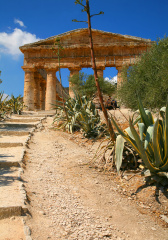CALATAFIMI SEGESTA
Dettaglio
Calatafimi Segesta, in the province of Trapani, is part of the archaeological site included in the Segesta Archaeological Park (itinerario). The myth of Aeneas is set in Calatafimi. The story tells that the hero chose the town as the place where the elderly and the “rebellious” women could rest.
The town is also known as Diceopoli, the city of justice. Calatafimi is geographically and anthropologically the settlement closest to the mythical civilisation of the Elymians, who populated the ancient Segesta.
We begin our discovery of Calatafimi by visiting a magnificent Doric temple dating back to the fifth century BC. The temple is in a wild and evocative landscape. We can also visit the Hellenistic-era theatre on Mount Barbaro. The cavea is partially carved into the rock, and the cave is known as Grotta Vanella. The grotto is a sacred place full of mystery and is connected to an older Sanctuary (in Contrada Mango). The cave and the Sanctuary create an ‘indigenous’ context of extraordinary importance.
These places have extraordinary archaeological value and, together with the quarries, represent the roots of Segesta, which also has precious Arab and Norman remains.
Crossing the historic centre, we step back into the Middle Ages. Today, all that remains of the Eufemius Castle (or Phimes Castle) are the ruins of the two towers at the north and south ends of the main façade. Once, the castle was a fortified site for the defence and control of the roads leading to Segesta. Then the manor became an outpost for Frederick II’s troops in the fight against the Muslims. Later it was the castle of the feudal lords of Calatafimi. From here, we could start a new journey to discover the castles of western Sicily. But before we go, let’s take some time to enjoy the view from the Belvedere over the valley. Art calls for art. The time has come to set out again to reach the Pianto Romano district. This place is rich in history, less ancient but no less glorious. It is part of the Segesta Archaeological Park.
Moving away from the town, we continue along the Strada Provinciale and reach the top of the hill where the battle between Garibaldi’s troops and the Bourbon army took place. Here, shrouded in surreal silence, stands the Pianto Romano Shrine and its obelisk, which preserves the bones of the soldiers killed in the Battle of Calatafimi on 5 May 1860.
The Mausoleum is 30 metres high, it can be seen from a great distance and is a triumph of Italian neoclassical art with Greek elements. Its severe and clean lines are in perfect harmony with the archaeological context of the area.
To visit the sites, you can buy the combined ticket online or at the ticket office of the Segesta Archaeological Park.
At the end of our full immersion in nature, art and culture, we can take an energising and refreshing dip in the clear, nearby waters of the wonderful Castellammare del Golfo.
A pentagram of flavours now awaits us: from the sweet notes of cassatelle alla ricotta cheese to the tempting ones of busiate with pork ragout, porchetta, caciotta degli elimi. And also oranges and prickly pears.
If you haven’t had enough, discover our route fromSegesta to Selinunte.
Share this content!
LOCATION





